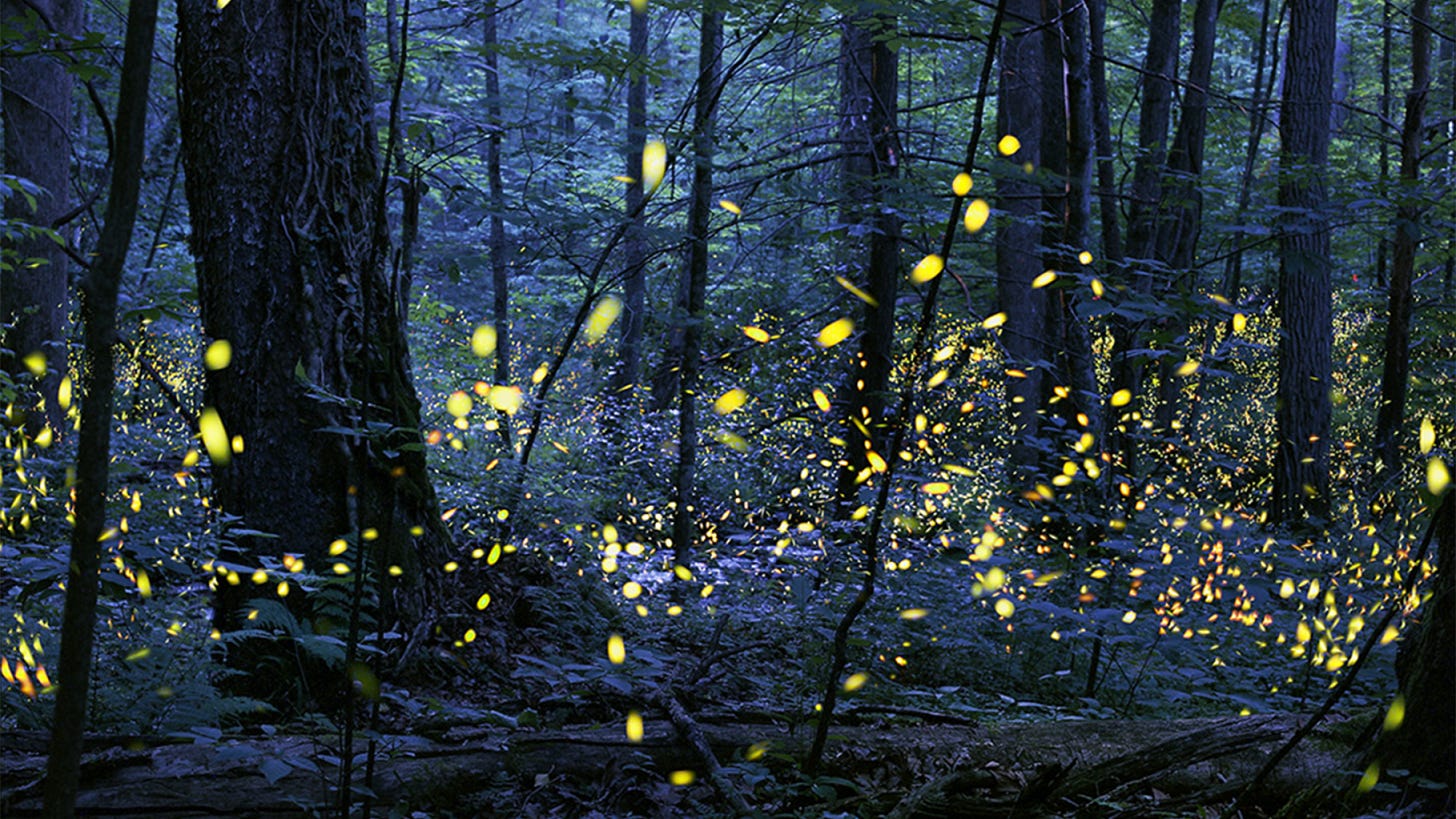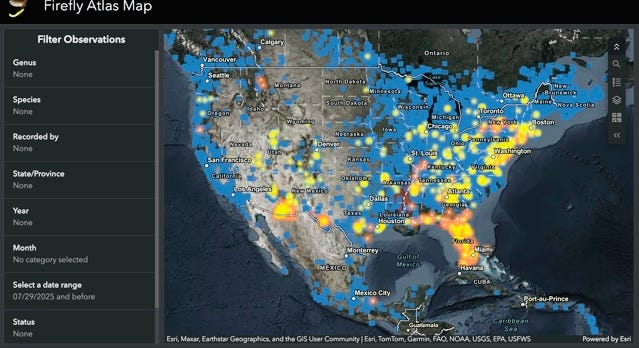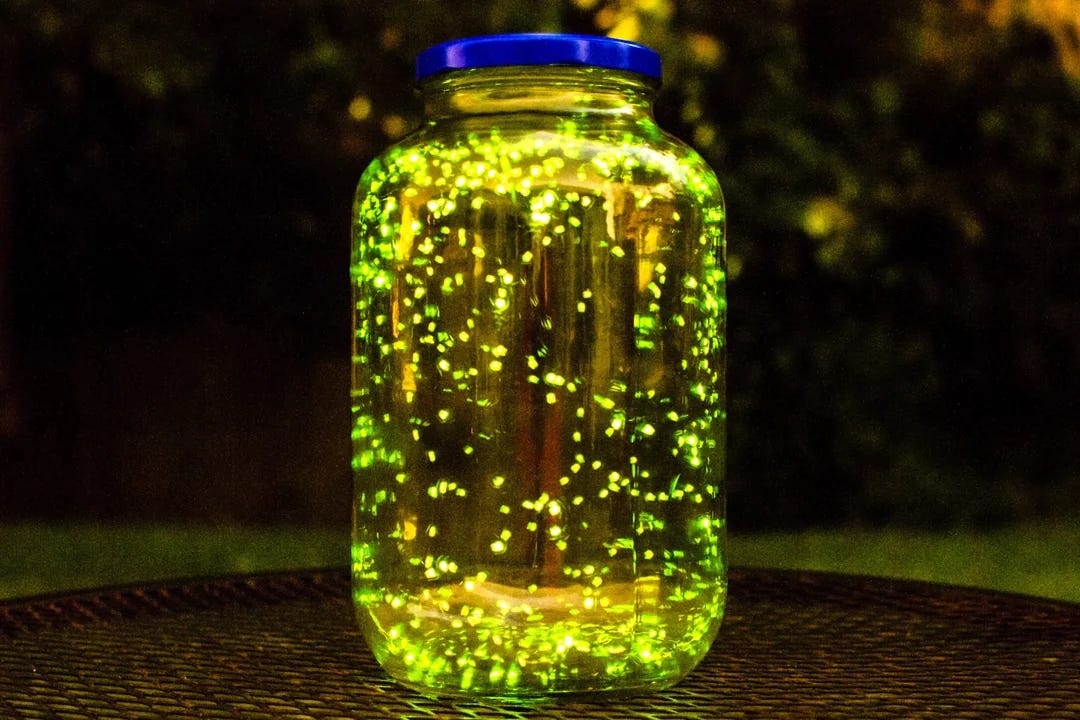At dusk in the summers of his later years, he enjoyed sitting in one of the Adirondack chairs arranged in a circle at the edge of the garden. As evening drifted in from the east and conversations moved from the corn looks tall for July to how long do you boil peppers before putting them in Mason jars, he would entertain guests young and old by squashing a number of just visiting for the summer fireflies between his fingers and rubbing their guts on his earlobes and ring finger, fashioning a pop up jewelry show of glow in the dark gemstone smears - always modeling them joyously - and delighting all who gathered. He was one of the best uncles anyone could have.
Welcome to the Firefly Summer edition of Ensōnomics.
Fireflies, lightning bugs, moon bugs, fire devils - whatever you want to call them - are having a moment.
It’s a summer of luminescence.
In Robert Greene’s Machiavellian masterwork, The 48 Laws of Power, Law # 16 goes something like this - once you’ve become well known and admired, use absence to increase value. Disappear for a while. People might wonder what you’re up to.
This would appear to have been the firefly’s long game the entire time.
After years of concern over their dwindling numbers, this summer’s reprieve and rally signals a kind of ecological comeback - and maybe a harbinger of what could still be a net gain in a world always at the mercy of entropy.
For decades, scientists and nature lovers have charted the slow disappearance of fireflies, noting a distressing decline in many regions due to habitat loss, pesticide use, light pollution, and climate shifts. The nonprofit Xerces Society, which has tracked insect biodiversity since the 1970s, lists over a dozen North American firefly species as threatened or endangered. In particular, the eastern United States had seen diminishing returns each July, with entire backyards once blinking with light now dimmed by years of development and chemically treated landscapes.
Random Note: There are over 2,400 species of fireflies.
And in a competition for most bioluminescent insect - the firefly wins, and well sorry, have to do it…wings down.
According to the Guiness Book of World Records, the brightest measured insect luminescence is the firefly species Pyrophorus noctilucus, which has been documented as having a surface brightness of 45 millilamberts. Plus there’s bonus science. The light emitted by fireflies is unique, as almost 100% of the energy is given off as light. In a lightbulb, only 10% of the energy is light with the other 90% given off as heat.
As for the 45 millilambert number -
A lambert is a unit of luminescence and equals 3,183 candelas/m².
A millilambert equals 3.183 candelas/m².
A candela is the base unit for measuring the intensity of light.
The mechanisms behind their glow are marvels of biochemistry. Fireflies produce light through a process known as bioluminescence, a chemical reaction involving the enzyme luciferase, the molecule luciferin - both named after Lucifer, and the presence of oxygen and ATP. The reaction is incredibly efficient, producing light with almost no heat, a benchmark that artificial lighting cannot replicate. The result is a soft, rhythmic pulse tuned to species specific patterns. Photinus pyralis flash in J shaped swoops. Female Blue Ghost fireflies, Phausis reticulata, who appear a pale blue green in person and neon green on camera, have no wings and you have to look in the grass to find them which isn’t as difficult as it seems since they glow up to a minute at a time.
This summer, while their bioluminescent displays have increased, scientists are quick to temper the enthusiasm. This is not a permanent recovery. It is, instead, a confluence of conditions - a serendipitous match between firefly biology and this year’s hydrology. A long, wet spring preserved moist habitats, especially in regions like the Mississippi River Basin and the Great Smoky Mountains, both biodiverse hotspots for lightning bugs. At the same time, a slight decrease in pesticide application, driven by more homeowners shifting to organic lawn care, may have helped boost larval survival. Firefly larvae are highly susceptible to chemicals like neonicotinoids, commonly used in conventional landscaping. If the community where you live sprays for mosquitos, fireflies still get caught in the crossfire of pyrethrins.
There’s also the quieter, less overt reason we’re seeing more fireflies. Our Reticular Activating System is firing on all cylinders - we’re looking - and here’s the thing - what you see is what you get. As populations shift towards a renewed interest in direct experience, particularly among younger generations, the popularity of insect tracking apps like iNaturalist and Firefly Watch has created new, communal rituals around observing the natural world. And what once might have passed unnoticed on a walk now becomes a shared moment and data point.
Feel free to click on the Firefly Atlas Map above should you want to look around.
While there’s a ton of data to unpack, there’s also a notable cultural rebound of fireflies. Perhaps it’s evidence of an emotions based economy, ensōnomics at play, across a population which still values wonder.
The firefly is unlike any other insect in its capacity to evoke wonder without freaking people out, acting as a soft ambassador between the insect world and our own, a rare creature that bridges the divide between scientific curiosity and poetic encounter. It doesn’t sting. Doesn’t bite. It effing glows.
“Children should still be allowed to catch and release just like most older people did as children. It is part of the magic…” Lynn Frierson Faust
Like the billfish and feelings, the firefly experience has evolved into a catch and release exercise. If you’d like to level up your technique, click on the long exposure fireflies in a jar photo below. No fireflies were harmed in the taking of this photo.
There’s something distinctly analog about them, too. Fireflies are a natural counter to optimization. Absolutely non linear. They set their own schedule. Their glow isn’t constant or bright in the way a streetlamp is, but episodic and momentary. In a summer season already marked by record heat, political fatigue, and Ai dystopian forecasts, the return of these creatures feels less like a distraction and more like a quietly coded message from the living world. Progress as needed, but be well paced, stay aware, be gentle.
Even amidst this summer’s abundance, underlying pressures remain. As urban expansion continues and climate patterns become more erratic, the fragile timing and habitats that fireflies rely on may not always align in their favor. The concern is this year’s brilliance marks not the beginning of a trend but a spike prior to another drop.
And yet, part of what makes this summer feel different is not just the science but the shared sentiment. Across social media platforms and backyard barbecues, the firefly has gone semi viral, not as content but as encounter. People aren’t just posting about fireflies. They’re organizing night walks, turning off porch lights, encouraging their kids to lie in the grass and wait. This kind of collective attentiveness, ephemeral as it may be, marks a shift. If the firefly’s light is a signal, perhaps we’re finally blinking back.
To live during a firefly summer is to remember that magic still exists in the margins. As July rounds its final days and the fireflies begin their slow retreat, their legacy lingers not in only their numbers but in the effect they’ve had on the people who noticed. They remind us that not every comeback needs to be engineered. Some just need a little space, a little dark, and a little rain. This was the summer the fireflies returned. And in their light, maybe we get a chance to see some things a little more clearly.
The Opposite of Attraction
No. The ocean is not playing tricks on you. And you’re not losing your mind.
The water is glowing.
Bioluminescence is one of nature’s simplest and most stunning chemical tricks. Found across land and sea, it’s the ability of living organisms to produce light through a chemical reaction. Whether it’s a blinking firefly in a backyard or the glowing surf of a tropical bay, the process is largely the same: the molecule luciferin combines with oxygen and is activated by the enzyme luciferase, producing a flash of light without heat.
Despite sharing this core mechanism, the purpose of bioluminescence varies dramatically depending on the environment. And so do the stories behind it.
On land, fireflies use light to attract. Each summer, male fireflies cruise low over fields and lawns, blinking in species specific rhythms. These flashes aren’t random. They’re signals, part of a courtship system developed over millions of years. A female firefly, perched on a nearby blade of grass, watches and responds only to the right pattern from the right species. If the male’s rhythm matches hers, she’ll blink back after a timed delay. This back and forth light exchange leads to mating. In this sense, firefly bioluminescence is all about visibility. It’s a living love letter broadcast into the dark.
In the ocean, it’s almost the opposite. In places like Mosquito Bay at the island of Vieques or the Indian River Lagoon in Florida, the bioluminescence comes from single celled plankton called dinoflagellates. These organisms don’t glow to attract; they glow to defend. They’re motion activitated by waves, fish, swimmers - any kind of disruption. Scientists believe this glowing response evolved as a kind of alarm system. A predator moving through a patch of bioluminescent plankton might find itself suddenly outlined in a burst of blue light, making it more visible to its own predators. In this case, light is not an invitation. It’s a deterrent.
So while both fireflies and dinoflagellates glow using the same chemical formula, the context shifts the meaning entirely.
Fireflies use light to signal safety and reproduction. Dinoflagellates use light to suggest danger and escape.
There’s also a difference in control. Fireflies can regulate their light deliberately. Their flashes are purposeful and timed, driven by neural and muscular control. Dinoflagellates, on the other hand, glow automatically when disturbed. There’s no rhythm or signal, only a bright burst triggered by outside forces.
Even the audience is different. Fireflies signal to each other. Their glow is part of a private conversation between insects. Dinoflagellates send their message outward, indiscriminately, often lighting up the water around fish, boats, or even human swimmers. Their light is not for mates or community but for confusion, panic, or self-protection.
Where the firefly’s light says “come closer,” the plankton’s glow says “stay the f away.” One is a beacon of attraction. The other, a warning flare.
Same light. Opposite intention.
The ensōnomics of it all.
A Light Hearted Song About Fireflies
You would not believe your eyes
If ten million fireflies
Lit up the world as I fell asleep
To View, click on Watch on YouTube icon
A Quote from the Guy Who Created Sherlock Holmes.
His sanguine spirit turns every firefly into a star. - Arthur Conan Doyle
The Endsō









